11.3 Toxic substances move through the environment and can accumulate in large concentrations
11.3–
The release of chemicals into the environment starts a chain of events with profound consequences for the health of humans and other animals, as well as for the environment as a whole. Even pollutants that occur at low levels can have an impact as they become more concentrated as they move through the food chain. Our unfettered release of chemicals leads to situations in which good dietary practices, such as the advice to eat fish that are high in omega fatty acids, must be countermanded by warnings to avoid fish that are high in the food chain because of mercury contamination and other toxic substances.
Pollution of the environment by humans on a global scale has a long history. The levels of heavy metals in the atmosphere began to increase about 7,000 years ago when humans first started to refine ores to extract metals such as copper and lead. During the height of the Roman Empire, smelters in Italy and Spain were producing as much as 100 million kilograms of lead, 15 million kilograms of copper, and more than 2 million kilograms of mercury each year. Pollution from these smelters spread around the world—
Only a few societies were refining such large quantities of metals 2,000 years ago, and the resulting pollution damaged mainly the environments close to the smelters. Farther away from the smelters, the concentrations of the metals and other toxins had been diluted below levels that could cause damage. In fact, “The solution to pollution is dilution” remained the slogan of many industries through the mid-

Pollution from metal smelting in the Roman Empire had a global reach. What does this suggest about pollution from today’s intense industrial activity?
solubility The amount of a substance capable of dissolving in a particular amount of solvent.
Toxic substances move through the environment, carried by air, water, and even the tissues of plants and animals. The solubility of a toxic substance generally determines how and where it moves in the environment or within an organism. Water-
bioaccumulation The absorption and increase in concentration of chemicals in organisms, over time, including potentially toxic chemicals. See biomagnification.
Persistent toxic substances that are retained within an organism build up to higher and higher levels over time, a process called bioaccumulation. As a consequence, larger fish (e.g., large tuna or swordfish) generally have higher concentrations of toxic substances such as mercury than do smaller, younger individuals in the population (Figure 11.10).
340

biomagnification An increase in concentration of a substance (e.g., heavy metals or fat-
The next step beyond bioaccumulation is called biomagnification (see also Chapter 3 and Chapter 13, pages 81 and 392), a process in which substances increase in concentration at each successive trophic level in a food chain. For instance, mercury released during the burning of coal may be deposited into a body of water with rain or snowfall, where algae, absorb it. Invertebrate animals and small fish retain mercury from the many algae they eat. Larger fish, in turn, eat large numbers of those smaller organisms, and the mercury is transferred to these predators’ bodies. As a result, the amount of the toxic substance increases at each successive trophic level—
DDT (dichlorodiphenyltrichloroethane) was first recognized as a contact poison of insects in 1939 and quickly put to use. It was widely used during and following World War II and was initially seen as a shining example of the accomplishments of industrial chemistry. DDT was inexpensive to manufacture, easy to apply, and it killed insects while apparently not harming humans. Photographs from that era show soldiers and civilians being sprayed with DDT to kill lice and other external parasites.
But the dark side of DDT became apparent as it spread into the environment: It is toxic to aquatic animals (fish and amphibians), and it causes cancer in some mammals. DDT also provided the first demonstrations of biomagnification. Its concentration in tissues increases from the bottom to the top of the food chain, and a breakdown product of DDT called DDE interferes with the formation of the eggshells of raptors, such as the California condor and peregrine falcons. The thin eggshells break during incubation, killing the developing embryo (see Chapter 3, page 81). Where the critically endangered condors along the California coast feed on the carcasses of sea lions with high concentrations of DDT and DDE, they have a nesting success rate of 20% to 40%. Meanwhile, the Arizona population of condors, which do not have access to the pesticide-
Think About It
Why are pregnant women and children advised to limit consumption of certain fish?
What is the difference between bioaccumulation and biomagnification?
If you’re concerned about the potential of consuming unsafe amounts of a known toxic substance, such as mercury, what should be the trophic position of the seafood you eat?